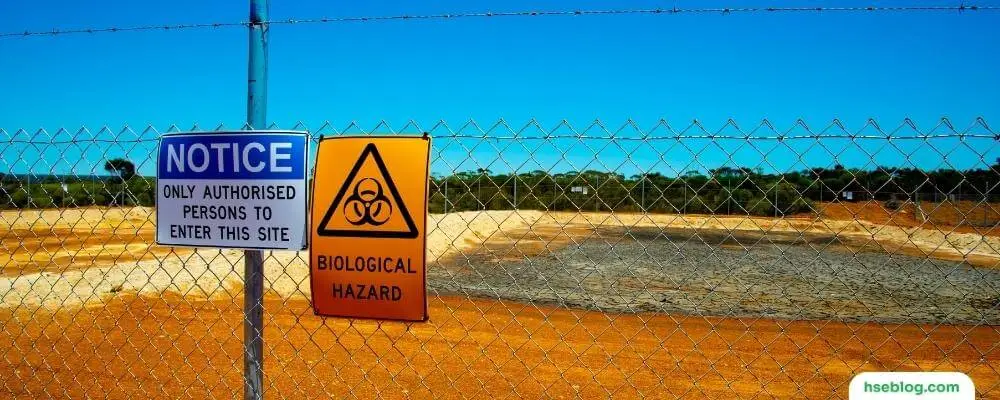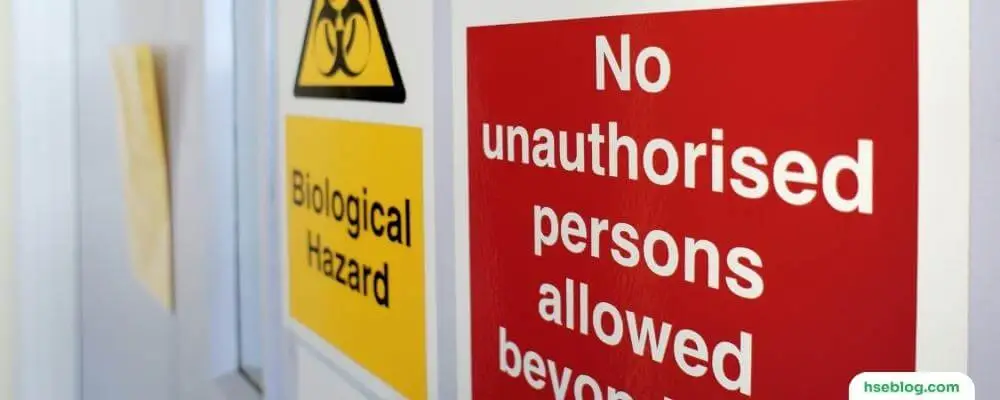In the complex environment of a construction site, physical dangers such as heavy machinery, falling debris, and challenging terrains often dominate safety considerations. However, a significant and less visible aspect of construction safety involves biological hazards, which can pose substantial health risks to workers. These hazards originate from diverse sources, including bacteria, viruses, insects, plants, birds, animals, and even humans, causing various health effects ranging from mild irritations to severe diseases.
This article explores the various types of biological hazards on construction sites, emphasizing their potential impacts and the importance of effective mitigation strategies. By understanding these risks, stakeholders in the construction sector can more effectively promote safer working conditions and enhance overall occupational health standards.
Biological Hazards On Construction Sites
Construction sites can expose workers to various biological hazards due to exposure to bacteria, viruses, insects, plants, birds, animals, and even humans. These biological hazards can result in various health issues, such as skin irritations, allergies, serious infectious diseases, and even cancer. Here’s a deeper dive into different types of biological hazards found on construction sites:
- Anthrax: This bacterial disease can be contracted through exposure to infected animals or animal products. It can result in skin, lung, and bowel disease.
- Antibiotic/Antimicrobial Resistance: The overuse of antibiotics has resulted in many bacteria and organisms becoming resistant to them, making infections more difficult to treat.
- Avian Influenza: Commonly known as bird flu, this virus can be contracted from infected birds and can cause severe respiratory illnesses.
- Bed Bugs: These insects can infest bedding, furniture, and clothing, causing itchy bites and potential allergic reactions.
- Clostridium difficile: A bacterium that can cause infections leading to severe diarrhea and life-threatening colon inflammation.
- Common Cold: A viral infection that primarily affects the nose and throat.
- Flood Clean-up: Following a flood, workers may be exposed to bacteria, mold, and viruses present in the flood water or in damaged buildings.
- HIV/AIDS: Viral infections that can be contracted through contact with infected blood, such as from a needlestick injury.
- Hantavirus: A severe and sometimes fatal respiratory disease that can be contracted through exposure to infected rodents or their urine and droppings.
- Hepatitis A, B, and C: Viral infections that primarily affect the liver, typically transmitted through contact with infected blood or bodily fluids.
- Histoplasmosis: A fungal infection that can be contracted by inhaling fungal spores from bird or bat droppings.
- Indoor Air Quality – Moulds and Fungi: These can cause respiratory problems, allergic reactions, and in some cases, serious lung infections.
- Influenza: A common viral infection that can be severe and even deadly for high-risk groups.
- Legionnaires’ Disease: A severe form of pneumonia caused by a bacterium found in water, including water used for drinking, bathing, and air conditioning systems.
- Lyme Disease: A bacterial infection transmitted by ticks, which can cause many symptoms, including fever, fatigue, and a characteristic skin rash.
- Methicillin-Resistant Staphylococcus Aureus (MRSA): A bacterium resistant to many antibiotics, making infections difficult to treat.
- Needlestick and Sharps Injuries: Can lead to bloodborne infections, such as HIV and hepatitis.
- Pandemic Influenza (Flu): A worldwide outbreak of a new influenza virus, which can be severe and spread quickly among workers.
- Psittacosis: A rare infectious disease transmitted to humans by certain birds, which can cause pneumonia-like symptoms.
- Q Fever: A disease caused by a bacterium common in animals. Humans can become infected through contact with contaminated dust.
- Rabies: A deadly viral infection that can be contracted from the bite of an infected animal.
- Toxoplasmosis: A disease caused by a parasite that can cause flu-like symptoms and potentially severe complications for people with weakened immune systems.
- Tuberculosis is a severe bacterial disease that primarily affects the lungs but can also affect other parts of the body. Tuberculosis spreads through the air when an infected person coughs or sneezes, which can easily occur on a crowded construction site.
- Working Safely around Stinging Insects: Insects such as bees, wasps, and hornets can threaten construction workers, particularly those allergic to insect stings. Workers may encounter nests or hives when working outdoors or in older structures.
- Zika Virus: This virus is transmitted primarily through mosquito bites but can also spread through sexual contact. The virus can cause birth defects if a pregnant woman is infected. Workers in areas with Zika-carrying mosquitoes are at risk.
- Asbestos Exposure: Although not a biological hazard in the typical sense, asbestos is a natural mineral that can have serious biological effects. When asbestos-containing materials are disturbed during construction, the fibers can be inhaled and cause diseases such as lung cancer and mesothelioma.
These are just some of the biological hazards encountered on a construction site. Construction workers must be aware of these hazards, and for construction companies to take appropriate measures to protect their workers. This may include providing appropriate training, implementing protective measures such as using PPE, and monitoring the health of their workers.

How Workers Can Expose To Biological Hazards In Construction
Construction workers can be exposed to various biological hazards due to the diverse construction tasks and environments. Here’s a more in-depth look at how these exposures can occur:
- Demolition and Renovation: During the demolition or renovation of structures, workers may come into contact with contaminated materials, such as lead paint or asbestos, which can cause serious health issues. Old structures may also have rodent infestations, bird or bat droppings, or mold growth, contributing to biological hazards.
- Sewer Work: Workers involved in sewer work or plumbing can be exposed to sewage, which contains many bacteria, viruses, and other pathogens. These can cause diseases such as hepatitis, leptospirosis, and others if protective measures are not followed.
- Work on Air Handling Systems: Air handling systems can host a variety of biological hazards, including bacteria, viruses, and fungi. Exposure can occur during repair, installation, or maintenance tasks.
- Soil and Water: Soil can harbor fungi and bacteria, while standing water can be a breeding ground for mosquitoes carrying diseases like West Nile virus or Zika. Workers involved in groundwork or those working in areas with poor drainage or standing water are at risk.
- Insect Vectors: Mosquitoes, ticks, and other insects can carry various diseases. Workers in outdoor or wooded areas are particularly at risk.
- Bird or Bat Droppings: Droppings can harbor bacteria and fungi, leading to diseases like histoplasmosis. Workers in areas with a high presence of these animals or those tasked with cleaning such droppings can be exposed.
- Animals: Workers can be exposed to rabies from bites or scratches from infected animals on-site.
- Landscaping and Clearing Operations: Removing plants, trees, and other foliage can expose workers to allergens and to insects like ticks that can carry diseases like Lyme disease.
- Working in Health Care Facilities: Construction workers tasked with renovating or building healthcare facilities can be exposed to various biological hazards, including bacteria, viruses, and other infectious materials.
- Old Structures and Buildings: These are likely to have accumulated dust, mold, and possibly asbestos, all of which pose biological hazards.
Protection from biological hazards in construction requires awareness, using personal protective equipment (PPE) correctly, and adherence to safety protocols. Workers should seek immediate medical attention if they believe they have been exposed to a biological hazard. Regular training on the potential hazards and safety measures can significantly reduce the risk of exposure.

How To Prevent From Biological Hazards On Construction Sites
Preventing exposure to biological hazards on a construction site involves several steps and strategies:
- Risk Assessment: The first step to prevention is understanding the risks. Conduct a thorough risk assessment to identify potential biological hazards on the site. This could include assessing the site for the presence of rodents or insects, checking for signs of mold, or considering the potential for exposure to diseases from human contact.
- Training: All workers should be trained to recognize the signs of biological hazards and understand the appropriate preventative measures. This includes handling materials safely, using protective equipment, and what to do during exposure.
- Personal Protective Equipment (PPE): Depending on the specific hazards present, workers may need to wear PPE such as gloves, masks, respirators, or protective clothing. Workers must be trained on how to use this equipment properly.
- Good Hygiene Practices: Encourage regular hand washing, especially before eating, drinking, or smoking. Provide clean toilet facilities and hand-washing stations. Avoid touching the face with dirty hands or gloves.
- Vaccination: In some cases, vaccines may be available and recommended to protect workers from certain biological hazards, such as Hepatitis B or influenza.
- Safe Work Practices: Implement and enforce safe work practices, such as proper waste disposal, safe handling of materials, and use of barriers to prevent exposure to hazards.
- Monitoring and Health Surveillance: Regularly monitor workers’ health, particularly those at high risk. If a worker becomes ill, it’s essential to identify the cause quickly and take steps to prevent further exposure.
- Site Cleanliness: Maintain a clean and organized work site to deter pests and prevent mold and bacteria growth.
- Communication: Keep lines of communication open. Workers should feel comfortable reporting potential hazards or health concerns and be informed of any identified hazards on the site.
Remember, prevention and early detection are key to protecting workers from biological hazards on construction sites. Regular training and maintaining an open dialogue about safety can help ensure a healthy work environment for all.
Conclusion
In conclusion, biological hazards on construction sites represent a significant but often overlooked threat to worker health and safety. They stem from diverse sources, from common bacteria, viruses, insects, and plants to larger animals and even humans. The health implications of these hazards can range from minor irritations and allergies to severe, potentially fatal diseases.
While physical hazards in construction receive considerable attention, understanding and addressing biological hazards are equally critical. Given the diverse nature of these hazards, mitigation strategies must be equally multifaceted, encompassing risk awareness, proper training, appropriate personal protective equipment use, and adherence to safety protocols. Immediate medical attention must be sought if a worker suspects exposure to a biological hazard.
Moreover, construction companies ensure their workers’ health and safety. This responsibility involves routine hazard assessments, worker health monitoring, and providing adequate resources for protective measures. As the construction industry continues to evolve and grow, so should its approaches to maintaining and enhancing worker safety. Managing biological hazards requires ongoing vigilance, proactive measures, and a commitment to health and safety in every aspect of construction work.

